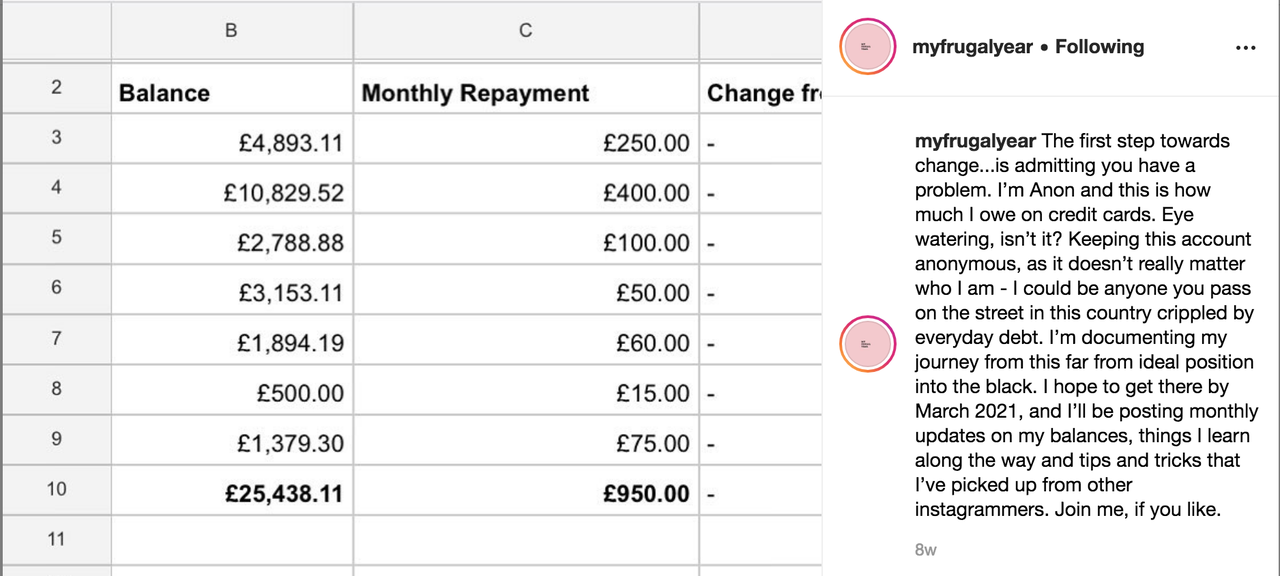“I know exactly how the influencer world works. I know how much people get paid to tout things on Instagram. But it didn’t make a blind bit of difference, I still ended up £25,000 in debt.”
Carla’s* spending started to spiral when she was planning her wedding. The 29-year-old mother from Bath would spend hours browsing wedding accounts on Instagram and Pinterest, but she quickly found herself deep in the world of micro-influencers selling her the ideal wedding.
From the best photographers to luxury florists and dressmakers, suddenly she found herself spending far beyond what her £27,500 salary could afford her.
What started as online fantasy quickly took on serious real-world consequences. She accrued between £18,000 and £20,000 of credit card debt “that was massively influenced by Instagram and Pinterest.”
Her spending escalated further when she moved house. She started making small purchases on credit: £50 on cushions, £150 on a new rug. These were items she hoped would help her fight the feeling of rental insecurity.
“Renting made me feel like I wanted to create an image of that insta-perfect life,” she said. “And if you’re shown something enough times, then you start to feel like you really, really want it and like you need it.”

Despite her mounting debt, she was inundated with positive reinforcement in the form of likes and comments whenever she posted images of her new purchases, something she found “extremely seductive”.
Purchasing in-platform, paying via PayPal, and linking her PayPal to her 0% credit card all contributed to the feeling that she wasn’t spending “real money”.
But Carla finally got her wake-up call when her cards reached the end of their 0% period. Almost overnight, she was facing huge repayments of hundreds of pounds on interest alone each month.
“Renting made me feel like I wanted to create an image of that insta-perfect life.”
- Carla
In March this year, she set up an anonymous Instagram account, MyFrugalYear, to come clean about her debt. “The first step towards change… is admitting you have a problem,” she wrote in her first post.
Carla is now hoping to pay off her credit card debts by 2021, and while she still has an impulse to spend occasionally, she said spending less time on social media has helped to remove the compulsion to spend.

While Carla’s story might seem extreme, it’s not unusual.
Just over a third 20- to 29-year olds agreed that social media posts by influencers made them spend money they otherwise would not have wanted to spend, according to an exclusive Comres poll commissioned by BBC Radio 5 Live and HuffPost UK.
Two in five (39%) of the 20- to 29-year olds agreed that targeted adverts on social media caused them to part with money they otherwise would not have spent.
For Marthe de Ferrer, a 25-year-old journalist and writer from Manchester, Instagram’s targeted adverts are able to “tap into exactly the sort of niche products I want”, and can make her spend recklessly if she’s not vigilant.
“I’m usually someone who frets over purchases, but I find Instagram or Facebook adverts seem to get me to part with up to £60 in one quick purchase, which is out of character for me,” she told HuffPost UK.
“There’s something about the bizarre specificity of Instagram adverts which hooks me every time. Tiny pots of cookie dough, travel pet-hair remover, personalised shampoo are all things I’ve bought on a whim – and regretted.”

Dr Chetna Kang, consultant psychiatrist at the Nightingale hospital – which housed the UK’s first tech addiction centre – specialises in treating technology addictions and behavioural addictions.
In the last five years, she has seen an “exponential increase” in patients suffering from behavioural disorders linked to social media, including shopping addiction.
“Shopping addiction has absolutely been exacerbated by the rise of social media,” she told HuffPost UK. “Previously it required effort to go in store and it was also something that other people would pick up on,” she said, adding that social media has made detecting shopping addiction in the digital age particularly difficult, and makes its grip on patients all the more pernicious.
“Targeted advertising is like going into a shop and seeing a dress, leaving without deciding to buy it, and then the shop assistant running after you and following you from shop to shop, and saying ‘Remember this dress? Want to buy it? How about now?’”
“There’s something about the bizarre specificity of Instagram adverts which hooks me very time.”
- Marthe, 25
Not all young people will fall into this trap, but those with underlying “vulnerability”, or those who use shopping as “retail therapy” are at particular risk of damaging behaviours.
Three quarters (74%) of the young people surveyed by Comres agreed that more restrictions should be placed on targeted ads on social media to protect vulnerable people with financial issues.
Dr Kang fears that tech addiction and behavioural problems associated with tech are “in danger of becoming an epidemic” and is calling for more education on the dangers of excessive use of social media.
Financial journalist and founder of The Young Money blog Iona Bain is similarly concerned. She believes Instagram’s move towards an e-commerce model is the “new debt danger for young people”. She thinks influencer accounts are too often “glorified advertising platforms”, with not enough transparency.
For Carla, who found herself in serious debt, it was advertisers operating in the same space as purchase platforms that made Instagram so lethal for her wallet – the purchase journey was just too quick. “I used to think, I can have it in two clicks and then it’ll be here and I’ll feel good for 30 minutes because I have a snapshot of that life,” she said.
Instagram’s new ‘checkout’ function will now make it even easier for users to make in-app purchases, something Bain worries will take important “friction” out of online shopping journeys and therefore dramatically decrease the time we have to consider the purchase before making it.
“In years gone by, you’d go to the shops and temptations would be around you but when you went home, you would have a break from the relentless commercial pressures of the modern world,” she said. “Young people don’t get a break now. It’s 24/7, they’re constantly on and they’re constantly being sold something.”
She believes consumer welfare will always be secondary to what is profitable for the platforms.
“[Tech addictions] are in danger of becoming an epidemic.”
- Dr Chetna Kang, consultant psychiatrist
“Tech companies are all working in an unholy and unhealthy alliance with each other to promote their own commercial interests,” she said. “To imagine they will ever take significant steps to increase friction and to make it harder for people to make impulse purchases, that’s pure fantasy.”
In September, the Advertising Standards Authority issued new guidance to influencers in a bid to increase transparency for consumers on social media. Influencers now must disclose whether they have been paid for a product, gifted it or loaned it. “No one should be left thinking that a tweet or Instagram post is just the person’s opinion when it’s not,” the ASA guidance reads.
HuffPost UK approached Instagram for comment for this piece. The site said it takes advertising on the platform seriously, and ads that breach community policies are removed. It said it would continue to review its ads policy to incorporate feedback.
Last year, the site created a branded content tool which allows influencers to add a “Paid Partnership” tag to their posts, in a bid to increase clarity around the commercial relationships that exist on Instagram.

Beth Sandland, a 23-year-old full-time blogger and influencer from London, agrees with the need for transparency but feels influencers can often be “judged too harshly” compared to media outlets like magazines.
“It’s generally known within the industry that editors receive a vast amount of press samples, that they favour features from paying advertisers and that journalists will be sent on press trips, but these things are rarely mentioned in the pages, or on the social accounts of the journalists who’ve reaped the rewards,” she said.
“I think influencers are held to a higher account – you wouldn’t ask a restaurant to tag #ad on their food photos, though technically it is – but if anything the new guidelines can only be a positive. They show that, slowly, the industry is being taken seriously,” she said.
A spokesperson for the Department for Digital, Culture, Media and Sport told HuffPost UK the government is planning a review into how online advertising is regulated in the UK “to assess the impact it has on society”, as part of plans to make the UK “the safest place in the world to be online”.
“Within the [magazine] industry... editors receive a vast amount of press samples... but these things are rarely mentioned in the pages, or on the social accounts of the journalists who’ve reaped the rewards.”
- Beth Sandland, influencer
For Bain, the crux of the issue is that regulation can’t keep up with an industry that is evolving at such pace. Instead, she believes young people need independent voices to keep calling out the dangers of this new digital frontier.
“When young people are engaging with influencers online, they are not engaging with people just like them. They are going into the online equivalent of a shop with a really pushy sales assistant. These are people that we think are like our friends, but they’re not. These are business people that want to make money. That sounds brutal, but that’s what I think,” she said.
“Influencers are people that we think are like our friends, but they’re not. These are business people that want to make money. That sounds brutal, but that’s what I think.”
- Iona Bain, financial journalist
For Carla, the solution needs to come straight from the source: the platforms themselves. She wants to see more transparency from tech companies to protect vulnerable young consumers from overspending.
“When I feel shit is when I want to spend more, because I want to make myself feel better,” she said.
“Instagram makes it seem really normal that you have loads and loads of disposable income and that is absolutely not the reality for most people... I think some kind of functionality to show how much you’re actually spending in-app would help make everything seem a bit more real.”
Some names have been changed.

#TwentiesTakeover
For one day HuffPost UK is joining forces with BBC Radio 5 Live to put people aged 20-29 at the forefront of the news agenda in a Twenties Takeover on Thursday 16 May.
Every 5 Live News programme will be co-presented by some of the most exciting new voices in the UK today, and HuffPost UK journalists will be reporting on issues that cut across the lives of young people – from the precarity of housing and work, to sexual health, the realities of modern dating and the pressure to keep up appearances on social media.
